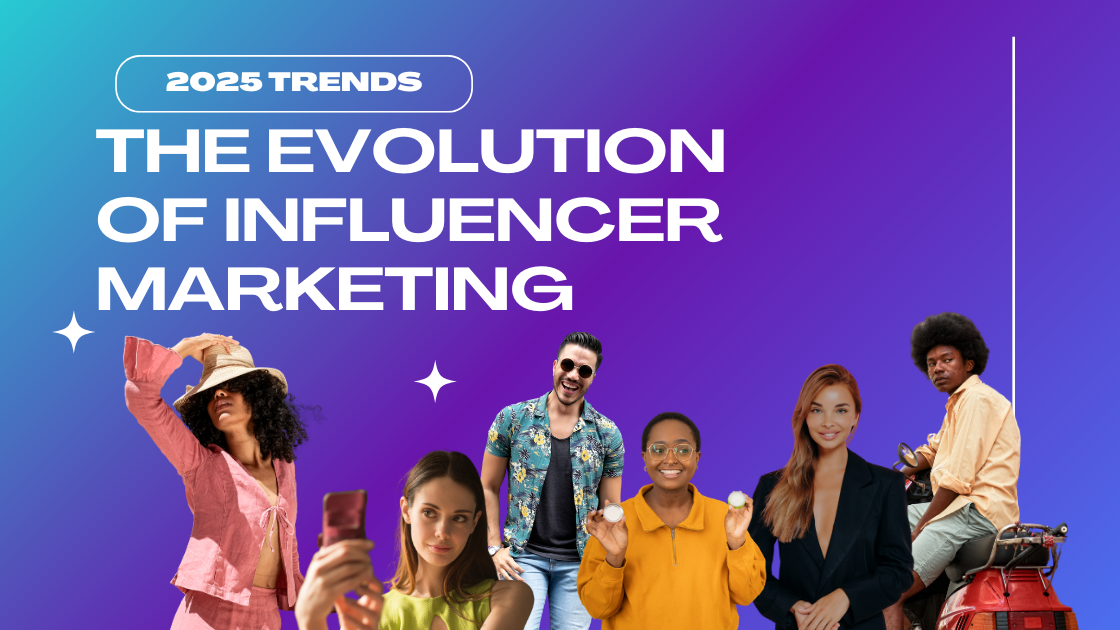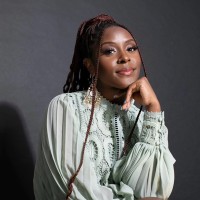It seems like just yesterday, influencer marketing was a fresh, new strategy that brands were cautiously dipping their toes into. Fast forward to today, and it’s not just a trend—it’s become a must-have in every marketer’s toolkit. Over the past decade, we’ve watched it grow from simple celebrity endorsements into a complex, dynamic ecosystem, rife with opportunity.
In 2025 and beyond, staying relevant will require more than just partnering with any influencer. It’s about discovering the authentic voices that truly resonate with today’s savvy, ever-evolving audience. As technology and consumer behaviors continue to shift, brands that fail to adapt risk being left behind.
Ready to find out what’s next? Let’s dive into the top trends and predictions that will shape the future of influencer marketing—and how your brand can stay ahead of the curve.
UGC gaining dominance, and how this plays into influencer marketing
User-generated content (UGC) and influencer marketing are both integral to social media, but they operate differently. UGC is often viewed as more authentic since it originates from everyday users rather than influencers. However, as the demand for relatable content grows, the distinction between UGC creators and influencers is fading, leading to rapid shifts in digital marketing.
UGC is valued for its authenticity, appealing to consumers who prefer content that feels genuine over polished advertisements that pack a hefty production price tag. As platforms continue to prioritize content that fosters real connections, UGC is becoming a key strategy for brands aiming to build trust and diversify their content. Hybrid campaigns combining UGC and influencer content are expected to rise. In fact, 79% of people say UGC highly impacts their purchasing decisions (Stackla), and 85% of consumers find UGC more influential (Adweek)
As the demand for authentic content increases, UGC creators are stepping into roles traditionally held by influencers. While influencers remain relevant, the definition is evolving to include UGC creators whose content feels more approachable. Brands are increasingly collaborating with these creators to produce organic and unscripted content to tap into their audience in a uniquely personal way.
The rise of UGC is reshaping influencer marketing. Brands may shift budget allocations towards campaigns that blend UGC with influencer partnerships, favoring micro and nano-influencers over high-profile influencers. This approach could democratize influencer marketing, making it more accessible to brands with smaller budgets and shaking up the influencer marketing space in a big way.
Hyper-Personalization Through AI
Hyper-personalization leverages AI and machine learning to deliver customized content that resonates with specific audience segments. Unlike traditional personalization, which may involve tailoring messages based on basic demographics, hyper-personalization uses advanced data analysis to create highly relevant and engaging content. Let’s dive into how AI is transforming influencer marketing and what we can expect as we head into 2025:
- Smarter Content: We all know that Creating content that truly connects with your audience isn’t a one size fits all solution. It’s a meticulously crafted, often time consuming art form to figure out what truly lands. This is where AI comes in. Imagine having a tool that can analyze what your audience has loved in the past and help you create content that resonates with them every single time. It’s like having a personal content assistant that allows influencers to craft posts that are more engaging than ever before.
- Matching with the Perfect Influencer: One of the toughest challenges in influencer marketing has always been finding the perfect influencers for your campaign. You need someone whose audience aligns with your brand and who feels like a natural fit, while also producing high-quality content. AI is revolutionizing this process by analyzing follower demographics, interests, and online habits to help brands connect with influencers who precisely match their target audience. Platforms like Find Your Influence simplify this process, eliminating guesswork and leading to more successful campaigns.
- Real-Time Personalization: We’re entering an era where real-time personalization will be revolutionary. AI tools are advancing rapidly, allowing influencers to adjust their messaging on the fly based on current trends and interactions. For instance, if a follower engages more with specific types of content, AI can suggest similar posts or help the influencer tweak their approach to keep content relevant and maintain high engagement. As authenticity becomes more crucial, being flexible and responsive will make content feel more genuine and tailored.
- Predicting What Works with AI: Picture this: your brand knowing exactly which content is going to take off before it even goes live. That’s the magic of predictive analytics. With AI, you can dive deep into past performance and current trends to make smarter, more informed decisions. Whether it’s pinpointing the perfect time to post or understanding what type of content will really resonate with your audience, AI is like having your own marketing crystal ball, giving you a glimpse into what’s going to work best.
How influencers and brands will impact Q4 purchasing behaviors
As seasons shift, brands are preparing for a key moment of the year: the launch of their latest collections. The move from summer to fall brings not only cooler weather but also a change in consumer behavior, as people look to refresh their wardrobes and embrace new trends. This timing aligns perfectly with the highly anticipated Fashion Weeks in New York, London, Milan, and Paris, where designers unveil their visions for the upcoming seasons. The excitement surrounding these events offers brands a prime opportunity to leverage influencers in introducing their new collections.
Influencers have become key players in the fashion industry, playing a crucial role in setting trends. As we approach New York Fashion Week and the major fashion capitals, expect influencers like, Mika Jaypa, known as @AsalaMalika in Instagram, to take center stage. They will attend runway shows, provide behind-the-scenes glimpses, and debut the season’s hottest pieces on their platforms. By curating looks that reflect their personal style, influencers will inspire their audiences on how to incorporate new trends into their own wardrobes.
Beyond fashion weeks, this period also serves as a strategic lead-up to Black Friday and the holiday season—times when consumer spending peaks. Brands understand the importance of building momentum before these shopping events, and influencers play a pivotal role in this strategy. Expect to see a variety of content, from try-on hauls and styling tips to sponsored posts showcasing key items as must-haves for the cooler months. Influencers will likely offer exclusive discount codes, engage in giveaways, and provide early access to collections—all aimed at driving consumer engagement and conversions.
The Rise of Brand Ambassadors
Brand ambassadors elevate the concept of long-term partnerships to the next level. Unlike influencers who may juggle multiple brand promotions, brand ambassadors typically commit to representing just one brand within a competitive space or a select few brands for an extended period. Take Holly Owens, known as @WealthyBelly on Instagram, as an example. She partners with brands that align with her daily health and wellness journey, consistently promoting them over time. At Find Your Influence, we’ve had the pleasure of working with Holly. She’s not just about creating high-quality content—she’s also incredibly discerning about the brands she endorses. Holly insists on trying products herself before committing to any partnership because she’s passionate about health and wellness for everyone. Anything she promotes meets her high standards. Here’s why we believe brand ambassadors like Holly are so important:
- Deeper Brand Connection: Brand ambassadors often develop a stronger connection with a brand’s values, mission, and products. This deep understanding allows them to create content that feels genuinely aligned with the brand, making their promotions more authentic and believable.
- Enhanced Community Building: Ambassadors typically have a closer bond with their followers, making them ideal for fostering a sense of community around a brand. They can cultivate loyalty and a feeling of belonging among their audience, which is crucial for a brand’s long-term success.
- Creative and Diverse Content: With ongoing partnerships, brand ambassadors have the flexibility to explore various types of content, from tutorials and behind-the-scenes peeks to Q&As and live streams. This variety keeps their content fresh and engaging, helping to avoid audience fatigue.
- Valuable Feedback Loop: Long-term relationships with brand ambassadors create a continuous feedback loop for brands. Ambassadors can provide insights about audience preferences, emerging trends, and potential challenges, helping brands fine-tune their products and marketing strategies in real-time.
Social responsibility: Political election informing the content that influencers post/what brands they work with
The 2024 U.S. political election is poised to be one of the most significant events of the decade. In today’s highly polarized environment, influencers are increasingly aware of their role in shaping public opinion, which extends to the content they post and the brands they align with. Looking back at previous elections, we’ve seen how political climates have directly influenced the content ecosystem. During the 2016 and 2020 elections, influencers found themselves at the crossroads of politics and social media. Some embraced the opportunity to voice their opinions, while others faced backlash for either staying silent or endorsing particular candidates.
This year, the stakes are even higher. Influencers are now more cautious and strategic about the content they share, understanding that their audience is not only consuming their lifestyle and entertainment content but also seeking alignment on values and beliefs. For brands, this presents both a challenge and an opportunity. Companies are expected to take stances on political and social issues, and the influencers they partner with become extensions of their brand identity. Brands that align with influencers who have strong, clear stances on key issues may deepen their connection with a loyal consumer base, but they also risk alienating others.
Influencers who are politically vocal will likely gravitate toward brands that share their values, while brands might choose to partner with influencers who align with their corporate ethos. This could lead to a more segmented market, where political and social beliefs play a crucial role in defining brand-influencer collaborations. As political discourse continues to intertwine with social media, the line between personal brand and political identity will blur even further, driving a new era of content creation that emphasizes values as much as visibility.
Growth of Creator Economy
The rise of the creator economy is transforming the influencer marketing landscape. We’re entering a new era where creators aren’t just following trends—they’re setting them. Here are a few trends we will see over the next year:
- Creators Becoming Entrepreneurs: Influencers are taking their personal brands to the next level by launching their own products, services, or businesses. Whether it’s a chic clothing line, a must-have beauty brand, or a cutting-edge digital course, creators are realizing that they have the audience and influence to build something entirely their own. This shift empowers them to take control of their income, shape their brand identity, and carve out a path for future growth on their own terms.
- Diversifying Revenue Streams: What’s even more exciting is how launching their own brands allows creators to diversify their income beyond just sponsored posts and ad revenue. This kind of financial independence is a game-changer. It means they’re not at the mercy of algorithm changes or shifting market trends. By owning a business, creators can monetize their influence in various ways—from e-commerce to subscription services—giving them the flexibility to grow and thrive no matter what comes their way.
- Turning Personal Brands into Empires: The move from influencer to entrepreneur is becoming a natural evolution in the creator economy. With a loyal audience that trusts their recommendations, creators have a built-in market eagerly awaiting their products. This not only opens up new revenue streams but also positions them as major players in their niche. As we look ahead to 2025, I bet we’ll see more and more creators turning their personal brands into full-fledged empires, setting new standards in the industry.
- Authenticity and Direct Engagement: One of the coolest aspects of creators launching their own brands is the level of authenticity it brings to their content. When influencers promote something they’ve personally created, their genuine passion and connection with the products are palpable. This direct engagement helps build even stronger relationships with followers, and, let’s be honest, it usually leads to better conversion rates, too.
- More Collaboration Opportunities: As more creators dive into brand ownership, the door to collaboration swings wide open. We’ll see influencers teaming up not just with traditional brands but with each other, combining their strengths and audiences to create unique products and experiences. This cross-pollination of ideas isn’t just exciting—it’s set to be a major driver of innovation and growth in the creator economy.
The value of influencers with specialized audiences/audiences within niche markets
With Instagram and TikTok being the top two downloaded apps in 2023 and a staggering 34 million videos posted each day, it’s clear that content creation shows no signs of slowing down. As more people become comfortable in front of the camera and embrace content creation, we’re witnessing a surge in self-proclaimed content creators. However, not all of these creators necessarily evolve into influencers. This distinction is expected to become more pronounced as expressing one’s interests and personality online through video content becomes the norm.
The motivations behind content creation vary. Some creators produce content with the aspiration of securing brand deals and achieving influencer status. For them, content is a means to an end—a pathway to influence and monetization. Others, however, create content driven by a desire to connect with like-minded communities and share their passions without the pressure of brand partnerships.
To stand out as a true influencer in this increasingly crowded space, creators must offer their audience tangible value—whether through education, entertainment, or inspiration. Equally important is having a unique selling proposition (USP) that differentiates them from others, making them attractive to both brands and audiences. While there are countless niches to explore, those who succeed are often the ones who focus on areas where they possess deep knowledge and can authentically engage, cutting through the noise and capturing the attention they seek.
Source: TikTok Stats 2023,Sprout Social. TikTok Statistics, The Social Shephard.
In a nutshell
As we approach 2025, the influencer marketing landscape is evolving in dynamic and exciting ways. Brands and influencers must navigate a world where authenticity, technology, and consumer expectations are in constant flux. Staying ahead requires not just understanding these shifts but adapting to them in a way that feels both genuine and impactful. With influencers becoming central to brand narratives and new opportunities emerging in niche markets, refining your strategy will be crucial for driving success and making a lasting impact.
Want to learn more about Influencer Marketing, especially on Mastering Multi-Platform Influence? Contact Find Your Influence today!
Learn more about the authors: Samantha Ley VP Client Development at Find Your Influence, Inc and guest Chanee Hylton Sr. Strategist at Laundry Service and Co-Founder of MELANIN MOI
Is your brand ready for the new year? Drop a comment with your thoughts on the ever changing landscape of Influencer Marketing!



